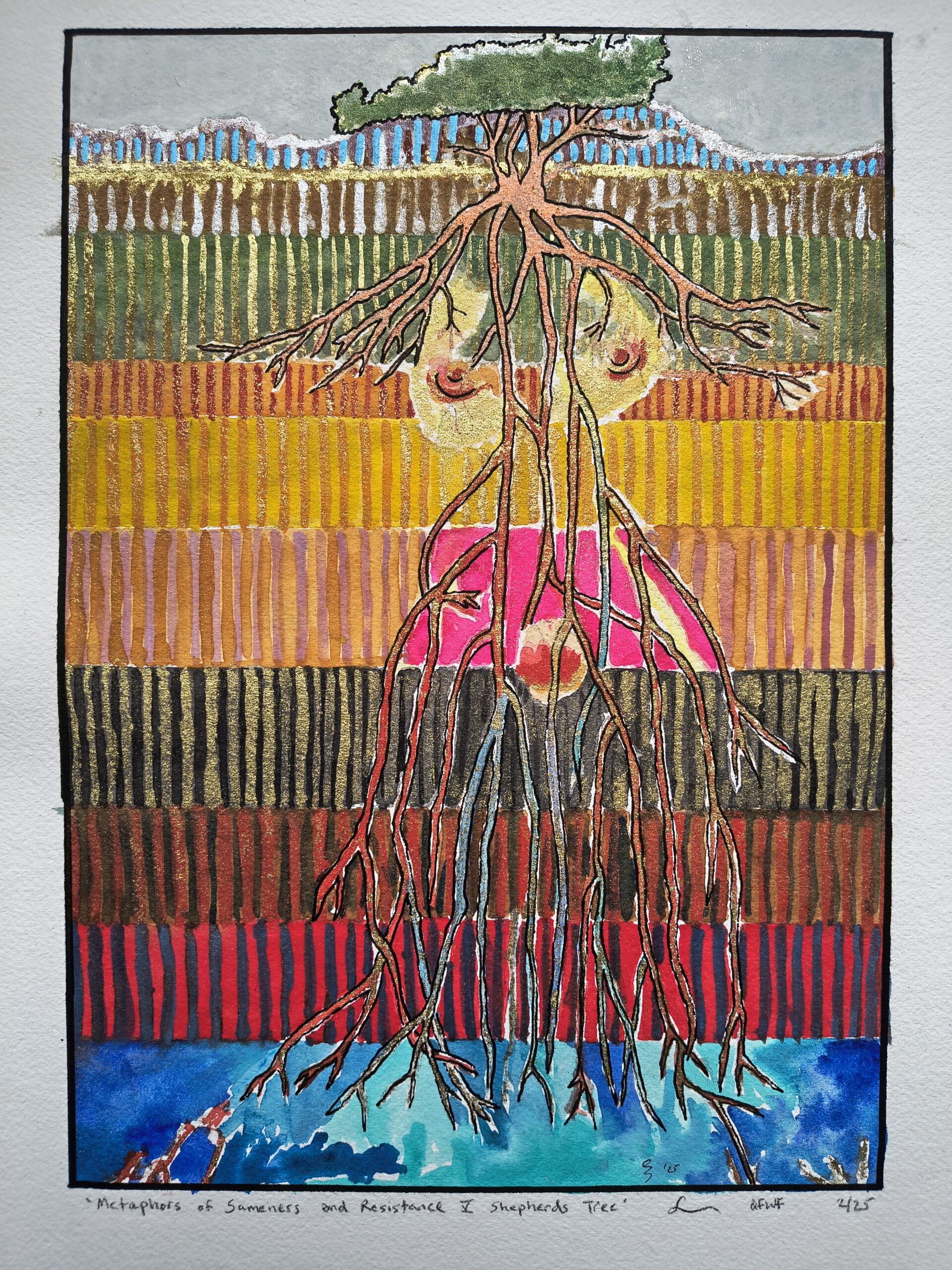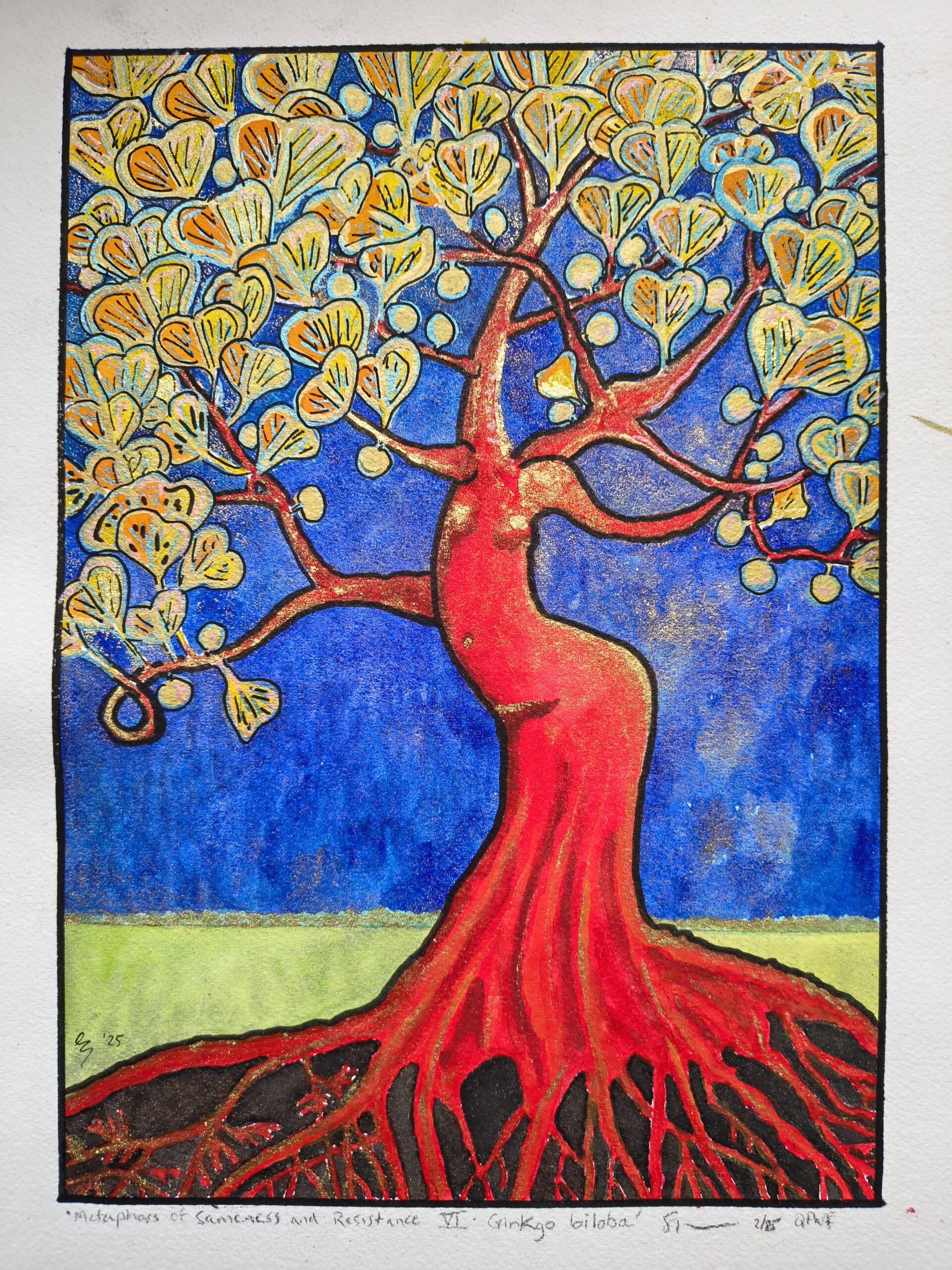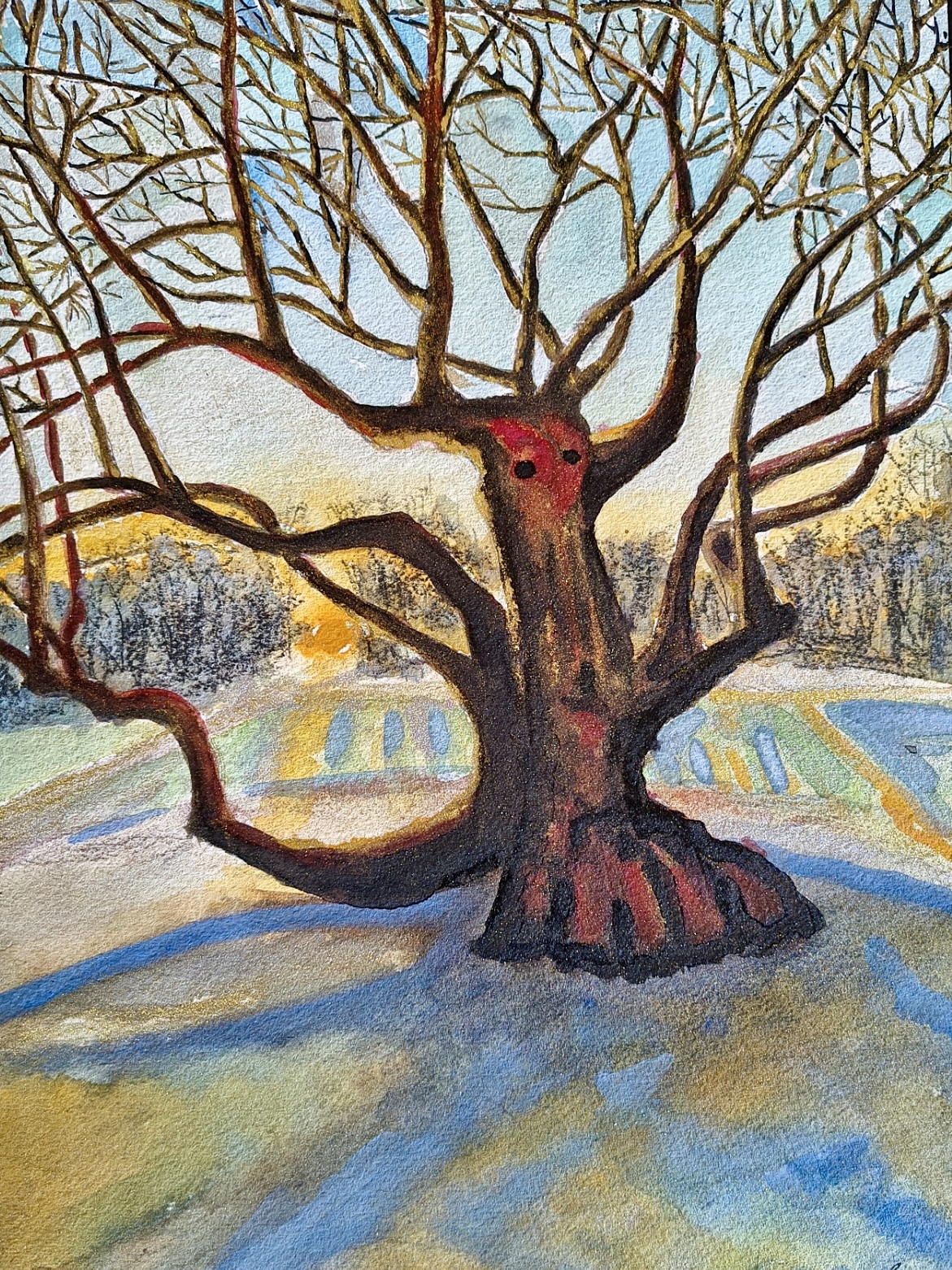Auteurs: Tycho Muijen & Greg Suffanti
Van bomen klimmen naar bomen verzorgen…
Sinds jongs af aan is natuur in al haar vormen en maten mijn grote passie geweest. En bomen zijn daar onlosmakelijk een onderdeel van. Met trots kan ik zeggen dan ik nu als volwassene voor een groot deel werk met bomen.
Als klimmend boomverzorger zorg ik dat mensen en bomen in harmonie samen kunnen leven (en sterven). In de praktijk komt dit neer op aanplanten, snoeien of wanneer het echt nodig is het veilig verwijderen van bomen. Dit doe ik meestal klimmend, waarbij ik mijzelf hoog in de boom veranker en zo gezekerd door de boom kan klimmen naar de locatie waar ik de snoei moet uitvoeren. Door met bomen te werken heb ik nog meer respect gekregen voor deze prachtige, soms immens grote wezens.

Aquarel Greg Suffanti
Greg: “The Shepherds Tree is also known as the Tree of Life. Another African native, the Boscia albitrunca is from the caper family and, at up 68 meters, they have the longest root systems in the world. Dutch settlers used the roots to make ‘coffee’, while wild animals eat the berries and leaves. The roots can be used to make beer, as well as to treat hemorrhoids. Some Namibian tribes believe their ancestors were born from the Shepherds Tree.
Given that the Shepherds Tree grows to only 10 meters, I chose a composition to highlight the trees impressive total size, focusing on the root system. Again, I’ve paid homage to the tree’s reputation as the Tree of Life by giving the roots an obviously feminine form. In our high fueled, high testosterone times, I’m trying to steer the viewer to their own roots…. Their own connection to their own cycle of life…. To being rooted in the truth. Just as in the previous aquarelle, the tree barely fits into the composition. I chose a boring, milky-grey light for the top of the composition, the star of the show being the roots, many layers of earth, with a water source of the composition to show how this majestic creature survives!”
Altruïsme van de boom
Bomen doen zoveel voor ons als mens en voor het gehele ecosysteem dat ons als mens in ons levensonderhoud voorziet. Bomen nemen CO2 op en ademen verse zuurstof uit, hierbij filteren ze de lucht van fijnstof, bevochtigen de lucht en werken als natuurlijke airco’s in steden en warme regio’s. Bomen vormen een onmisbare biotoop voor talloze schimmels, korstmossen, planten, geleedpotigen, insecten, reptielen, vissen, amfibieën, zoogdieren, vogels en vleermuizen. Bomen leggen de aarde vast in oevers, moerassen en berghellingen en zorgen hiermee voor veiligheid voor de mens. Bomen (fruit) voorzien ons van voedsel (fruit, noten) en onmisbare bouwmaterialen (hout). Ten slotte zijn bomen door hun grote omvang belangrijke landschappelijke elementen en zorgen bomen hiermee voor een prettige leefomgeving voor de mens.

Aquarel Greg Suffanti
Greg: “Metaphors of Sameness and Resistance IV Baobab Tree is one such tree that embodies the Tree of Life, which it is often called. Native to Madagascar, mainland Africa and Australia, these tubular giants can hold up to 120,000 liters of water and live for 2,000 years. It’s fruit and pulp are used in making beverages, cooking and baking. Further, the fruit is an antioxidant and considered a superfood, rich in citric acid, oil, vitamins C and B, iron, calcium and fiber.
Given all of these life sustaining qualities I looked at this representation of the Baobab tree as the Tree of Life, giving her an obviously female form…. Mother Nature protecting and sustaining life. I chose bright colors to reflect the natural environment of the Baobab tree. I’ve often chosen a setting sun in the composition to suggest a negative turn to the narrative, however, in Metaphors of Sameness and Resistance IV, I chose the setting sun to reflect that days and nights come and go many, many times in a species that can live to be 2,000 years old! I tried to have the tree just fitting into the composition to suggest a majestic size…. A giant in our world.”
Leven onder de grond
De laatste jaren wordt steeds duidelijker dat bomen ook onderling kunnen communiceren en elkaar, wanneer dit nodig is, kunnen helpen met overleven. Bomen zijn dus sociale wezens die via wortel en symbiose vormende schimmels met elkaar communiceren en hiermee enorme gemeenschappen (bossen) kunnen vormen.
Bomen zijn er in alle soorten en maten. Van het hoge noorden en ruige berggebieden tot tropische regenwouden, ieder biotoop kent zijn eigen soorten bomen met soortspecifieke kenmerken. Deze enorme verscheidenheid aan soorten maakt bomen een onuitputtelijk interessant onderwerp dat met de huidige tijd alleen maar belangrijker wordt.
Liefde voor bomen als praxis voor wereldburgerschap
I feel like I’m part of an underground movement working from the roots up!
Greg: “I read every day in the New York Times about the despair and feelings of powerlessness of so many people as they watch their government change before their eyes. The changes even come hourly…. My mom has given up watching the local DC news channels. I myself feel affected in a way I hadn’t quite expected…. It’s not so much the actions, it’s their number and sheer velocity that is disorienting. I know this is the Orban playbook on steroids, but I can’t help but wonder if the America I know and grew up in is soon to be unrecognizable to me? Such a momentous time in history. Such speed in the above-world, such comfort in the slow and steady life of a tree…. The underworld!
In that regard I feel happy and relieved to have found something that speaks to me, and with urgency, to productively channel my energies into, rather than feeling like a defeated and deflated observer. The more I get deeper into this world of trees, the more I feel inspired to capture the spirits of these witnesses to history…. Who teach, inspire and sustain life…. Connecting to a mother-earth energy….. Rather than the fear and confusion of the moment.
As I read the headlines both here and abroad it really strikes me that the QfWf-project about wereldburgerschap has been riding the tide of hate and intolerance all along, and now, the giants swells of radical changes and ideas threaten to engulf our sense of right and wrong, and even to fully justify the physical separation of those from their homelands. When genocide is being openly discussed it’s clear that the world is entering, or rather re-entering, the most shameful and reprehensible parts of our seemingly forgotten past.”
In thinking about the current state of the world, I also started thinking about the different kinds of trees that adapt to changing and sometimes radical shifts in their environments in order to survive… Again in the context of a metaphor for the human condition, especially the issue of survival. Perhaps you have some ideas of your own about these kinds of trees which are highly adaptable and live for ages, witnessing history as it evolves?
Baobab tree from Madagascar… Also called the Tree of Life, it can hold up to 120,000 liters of water and live for 2,000 years. Louise Müller, intercultural philosopher especially on African philosophy reminds us of an Akan proverb (Ghana):
Wisdom is like a baobab tree; no one individual can embrace it.
Louise: “Dit spreekwoord hoort bij het verhaal van de spin Anansi en de wisdom pot: de spin Anansi bewaart alle wijsheid voor zichzelf in een pot tot hij er in een mislukte poging om zijn wijsheidspot in een boom te verstoppen achter komt dat zijn zoon meer weet dan hijzelf.
Het blijkt dus voor Anansi onmogelijk te zijn om in zijn eentje alle wijsheid van de hele wereld te bewaren. Alle mensen jong en oud, licht of donker, dik of dun hebben wijsheid. Niemand heeft alle wijsheid van de wereld, maar iedereen heeft wijsheid in zich.”
Shepherd’s Tree, native to the Kalahari desert, having 70 meter roots, enabling it to thrive with little to no regular water from rainfall.
Ginkgos, which are called ‘living fossils’, trees unchanged in over 200 million years, before dinosaurs roamer the earth… Highly adaptable to almost any conditions and representing many species. Their fan-shaped leaves have come to represent peace amidst destruction, and hope in face of despair! How appropriate!

Aquarel Greg Suffanti
Gerelateerde artikelen
Beeldende Kunst, Blog, Praktijken van wereldburgerschap



